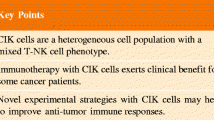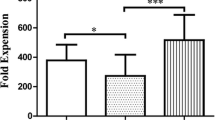Summary
Human peripheral blood mononuclear cells (PBM) activated with recombinant interleukin-2 (IL-2) generate potent lytic activity (LAK) against a variety of malignant cells. IL-2 alone is sufficient for LAK generation, but high concentrations are needed to generate optimal cytotoxicity. Our recent studies based on combinations of biological agents indicated that alternative activation pathways may exist. Synergy for LAK induction was investigated using IL-2 and tumor necrosis factor-α (TNF). Single-cell suspensions of primary human lung carcinomas were prepared from seven established cell lines and 32 fresh tumor specimens. Not only were all cell lines sensitive to allogeneic LAK, but also all fresh tumors were sensitive to some degree to both autologous and allogeneic LAK lysis measured by a 4-h 51Cr-release assay. LAK-mediated cytotoxicity, induced with a combination of human recombinant IL-2 (Cetus, 100 U/ml) and TNF (Genentech, 500 U/ml), showed a mean fourfold increase (range 0.7–16.3) over IL-2 alone. No lytic activity was generated from PBM incubated with media or TNF alone. The sequence dependence of adding IL-2 and TNF in enhancing cytolytic activity was also studied. In vitro kinetics data revealed that the addition of TNF 2–6 h before the addition of IL-2 greatly increased LAK activity over that obtained from the simultaneous addition of the two cytokines. These results demonstrated (a) the synergy of IL-2 and TNF for generating LAK; (b) the lysis of fresh primary lung cancer cells by LAK; and (c) the sequence dependence of IL-2 and TNF for the induction of optimal LAK activity.
Similar content being viewed by others
References
Belldegrum A, Upperkamp I, Rosenberg SA (1988) Anti-tumor reactivity of human lymphokine activated killer (LAK) cells against fresh and cultured preparations of renal cell cancer. J Urol 139:150
Brouer M, Carney DN, Ole HK, Gadzar AF, Minna JD (1986) Growth of cell lines and clinical specimens of human non-small cell lung cancer in a serum-free defined medium. Cancer Res 46:794
Brown CC, Kessler LG (1988) Projections of lung cancer mortality in the United States: 1985–2025. J Natl Cancer Inst 80:43
Dutcher JP, Creekmore S, Weiss GR, Margolin K, Markowitz AB, Roper MA, Parkinson D (1987) Phase II study of high dose interleukin-2 and lymphokine-activated killer cells in patients with melanoma. Proc Am Soc Clin Oncol 6: A970
Eggermont AMM, Stellar EP, Ottow RT, Matthews W, Sugarbaker PH (1987) Augmentation of interleukin-2 immunotherapeutic effects by lymphokine-activated killer cells and allogeneic stimulation in murine tumor cells. J Natl Cancer Inst 79:983
Fisher RI, Coltman CA, Doroshow JH, Rayner AA, Hawkins MJ, Mier JW, Wiernik P (1987) Phase II clinical trial of interleukin-2 plus lymphokine-activated killer cells in metastatic renal cancer. Proc Am Soc Clin Oncol 6: A959
George RE, Loudon WG, Moser RP, Brunner JM, Stek PA, Grimm EA (1988) In vitro cytolysis of primitive neuroectodermal tumors of the posterior fossa (medulloblastoma) by lymphokine-activated killer cells. J Neurosurg 69:403
Grimm EA (1986) Human lymphokine-activated killer cells (LAK cells) as a potential immunotherapeutic modality. Biochim Biophys Acta 865:267
Grimm EA, Rosenberg SA (1984) The lymphokine-activated killer cell phenomenon. In: Pick E (ed) Lymphokines. Academic Press, New York, p 279
Grimm EA, Mazumder A, Zhang HZ, Rosenberg SA (1982) Lymphokine-activated killer cell phenomenon. J Exp Med 155:1823
Grimm EA, Crump WL, Durett A, Hester JP, Lagoo-Deenadalayan S, Owen-Schaub LB (1988) TGF-Beta inhibits the in vitro induction of lymphokine-activated killing activity. Cancer Immunol Immunother 27:53
Itoh K, Tilden AB, Balch CM (1986) Lysis of human solid tumor cells by lymphokine-activated killer cells. J Immunol 136:3910
Kradin RL, Boyle LA, Preffer FI, Callahan RJ, Barlai-Kovach M, Strauss HW, Dubinett S, Kurnick JT (1987) Tumor-derived interleukin-2 dependent lymphocytes in adoptive immunotherapy of lung cancer. Cancer Immunol Immunother 24:76
Little CD, Nau MM, Carnery DN, Gadzar AF, Minna JD (1983) Amplification and expression of the c-myc oncogene in human lung cancer cell lines. Nature 306:194
Marumo K, Ueno M, Muraki J, Baba S, Tazaki H (1987) Augmentation of cell-mediated cytotoxicity against renal carcinoma cells by recombinant interleukin-2. Urology 20:327
Mazumder A, Rosenberg SA (1984) Successful immunotherapy of natural killer-resistant established pulmonary melanoma metastasis by the intravenous adoptive transfer of syngeneic lymphocytes activated in vitro by interleukin-2. J Exp Med 159:495
Minna JD, Higgins GA, Glatstein EJ (1985) Cancer of the lung. In: Devita VT, Hellman S, Rosenberg SA (eds) Principles and practice of oncology. J B Lippincott, Philadelphia, p 523
Mule JJ, Shu S, Schway SL, Rosenberg SA (1984) Adoptive immunotherapy of established pulmonary metastasis with LAK cells and recombinant interleukin-2. Science 225:1487
Nishimura T, Ohta S, Sato N, Togashi Y, Goto M, Hashimoto Y (1988) Combination tumor-immunotherapy with recombinant tumor necrosis factor and recombinant interleukin-2 in mice. Int J Cancer 40:255
Ostensen ME, Thiele DL, Lipsky PE (1987) Tumor necrosis factor-alpha enhances cytolytic activity of human natural killer cells. J Immunol 138:4185
Reference deleted
Owen Schaub LB, Gutterman JU, Grimm EA (1988) Synergy of tumor necrosis factor and interleukin-2 in the activation of human cytotoxic lymphocytes. Cancer Res 48:788
Rosenberg SA, Lotze MT, Muul LM, Leitman S, Chang AE, Ettinghausen SE, Matory YL, Skibber JM, Shiloni JM, Vetto JT (1985) Observations on the systemic administration of autologous lymphokine-activated killer cells and recombinant interleukin-2 to patients with metastatic cancer. N Engl J Med 313:1485
Rosenberg SA, Mule JJ, Spiess PJ, Reichert CM, Schwarz SL (1985) Regression of established pulmonary metastasis and subcutaneous tumor mediated by the systemic administration of high dose recombinant interleukin-2. J Exp Med 161:1169
Rosenberg SA, Lotze MT, Muul LM, Chang AE, Avis FP, Leitman S, Line WM, Robertson CN, Lee RE, Rubin JT, Simpson CG, White DE (1987) A progress report on the treatment of 157 patients with advanced cancer using lymphokine-activated killer cells and interleukin-2 or high dose interleukin-2 alone. N Engl J Med 316:889
Scheurich P, Thomas B, Ucer U, Pfizenmaier K (1987) Immunoregulatory activity of recombinant human tumor necrosis factor-alpha: induction of TNF receptor on human T cells and TNF-alpha mediated enhancement of T cell responses. J Immunol 138:1786
Sculier JP, Body JJ, Nejai S, Glibert L, Themelin L, Klatersky J (1988) Endogenous production of tumor necrosis factor-alpha in cancer patients during adoptive immunotherapy with interleukin-2. Proc Am Assoc Cancer Res 29:403
Sosman JA, Kohler PL, Hank J, Moore KH, Bechhofer R, Storer B, Sondel PM (1988) Repetitive weekly cycles of recombinant human interleukin-2: responses of renal carcinoma with acceptable toxicity. J Natl Cancer Inst 80:60
Topalian SL, Rosenberg SA (1987) Therapy of cancer using the adoptive transfer of activated killer cells and interleukin-2. Acta Haematol (Basel) 78:75 (suppl)
West WH, Tayer KW, Yannelli JR, Marhsall GD, Orr DW, Thurman GB, Oldham RK (1987) Constant infusion recombinant interleukin-2 in adoptive immunotherapy of advanced cancer. N Engl J Med 316:898
Winkelhake JL, Stampfl S, Zimmerman RJ (1987) Synergistic effects of combination therapy with human recombinant interleukin-2 and tumor necrosis factor in murine tumor models. Cancer Res 47:3948
Author information
Authors and Affiliations
Additional information
This work was supported by NCI Grants RO2-CA45225 and CAO 9611-01, and by an award from the Prouss Foundation
Rights and permissions
About this article
Cite this article
Yang, S.C., Owen-Schaub, L., Grimm, E.A. et al. Induction of lymphokine-activated killer cytotoxicity with interleukin-2 and tumor necrosis factor-α against primary lung cancer targets. Cancer Immunol Immunother 29, 193–198 (1989). https://doi.org/10.1007/BF00199995
Received:
Accepted:
Issue Date:
DOI: https://doi.org/10.1007/BF00199995




